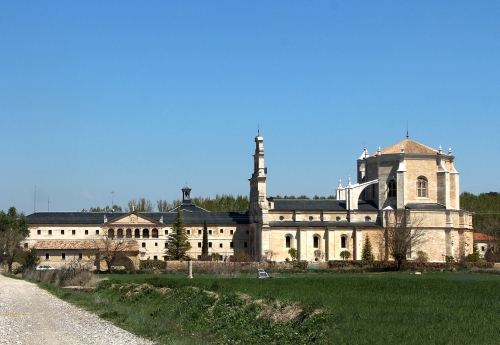Route of the Monasteries

We're going on a monastic route through the Ribera del Duero, passing through various artistic styles and different congregations along our Wine Route. We will make stops at these five points.
- Monasterio de Santa María de La Vid (La Vid) BIC
- Real Monasterio de Santo Domingo (Caleruega)
- Santuario de San Pedro Regalado (La Aguilera)
- Convento de San Pablo (Peñafiel) BIC
- Monasterio de Santa María de Valbuena (San Bernardo)
We begin this Monastic Route in the Burgos region. The Monasterio de Santa María de la Vid, located on the banks of the Duero River, is currently occupied by Augustinian monks, and was founded in the 12th century, with expansions in the 13th century. In the 16th century, the entire building was renovated under the patronage of Abbot Don Íñigo López de Mendoza, a member of the influential Zúñiga-Avellaneda family. The grand Baroque bell tower, completed in 1734, at the entrance of the temple contrasts with the simplicity of the building.
We make a stop in Peñaranda de Duero, where we find the Monasterio de las Madres Franciscanas Concepcionistas, whose church features a suggestive Mudejar coffered ceiling and a beautiful Renaissance courtyard.
We continue our journey to Caleruega. The history of the Real Monasterio de Santo Domingo de Guzmán dates to two years after the death of Saint Dominic (1221). Initially, a chapel was built, and later, King Alfonso X the Wise, who was related to the Guzmán family, had a Gothic church constructed. The ancestral home was later transformed into a convent, and a community of nuns from San Esteban de Gormaz (Soria) moved there, receiving the privilege of Lordship over the place. It is interesting to visit the Crypt (where the "Pocito," a well that indicates the exact spot where Saint Dominic was born, stands out), the cloister, built between the 13th and 15th centuries, the Museum, housed in a Gothic room, which displays highly artistic and historical pieces, and the Monastic Archive, which preserves important documents, including the oldest one dating back to the 10th century.
Our next stop is in La Aguilera, just 10 km from Aranda de Duero, to visit the Santuario de San Pedro Regalado, whose original name is Monasterio Domus Dei. It has its origins in the 14th century, in a hermitage erected near the town. Noteworthy is the octagonal chapel of San Pedro Regalado, with a prominent lantern crowned with a slender slate spire.
We continue our route, now entering the province of Valladolid, to visit the Convento de San Pablo in Peñafiel. In the former fortress of Alfonso X, the Wise, the Infante Don Juan Manuel built the current Gothic-Mudejar convent in 1324, where he was buried. His remains rest in a plateresque chapel with Gothic reminiscences, an outstanding piece of Spanish Renaissance art.
We conclude this monastic tour at the Monasterio de Santa María de Valbuena, a gem of religious architecture from the 12th century, corresponding to the late Romanesque period. Construction began around 1165 and was completed in the early 13th century. The stone complex perfectly exemplifies the Cistercian typology of self-sufficiency and austerity established in the reform of Saint Bernard. Located on the banks of the Duero River, in the hamlet of San Bernardo, the Cistercian monastery of Benedictine monks was a place of retreat, prayer, and wine production. Currently, it houses the headquarters of the Fundación de las Edades del Hombre.




